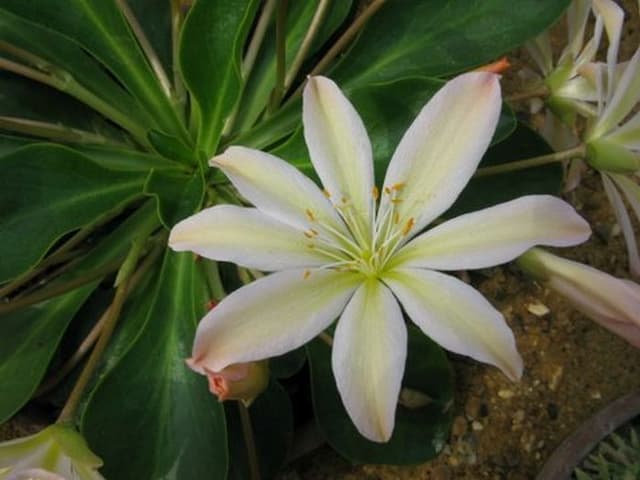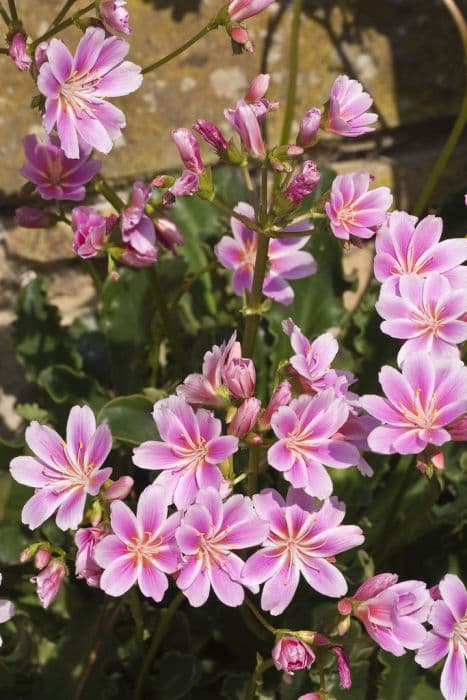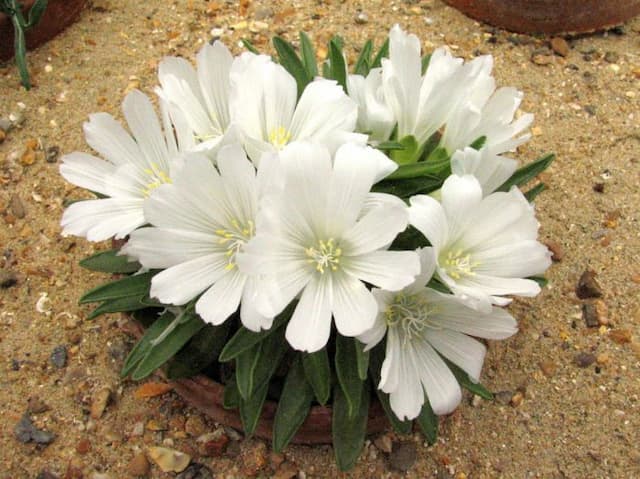Cliff Maids Lewisia cotyledon

ABOUT
The plant, known by the common name Lewisia cotyledon, is recognized for its attractive, rosette-forming foliage and showy flowers. The leaves are fleshy and spoon-shaped, often with a green to bluish-green hue, and can have a waxy or slightly succulent texture. This basal rosette of leaves contributes to the ornamental value of the plant throughout the year. When in bloom, the Lewisia cotyledon produces clusters of flowers atop sturdy, slender stalks that rise above the foliage. The flowers themselves are star-shaped and come in an array of colors, including pink, orange, yellow, white, and red, often with subtle gradients and various hues within each petal. Some varieties might even display stripes or speckled patterns, adding to the visual interest of the blooms. The flowers are typically multi-petaled with several concentric circles of petals, each layer usually smaller and more delicate as it nears the center. The overall effect of the blooming Lewisia cotyledon is a bright and eye-catching display that adds color and vibrancy to rock gardens, alpine collections, or any garden setting where the beauty of its flowers can be appreciated up close. The contrast between the lush, ground-hugging leaves, and the blossoms perched on their upright stalks gives this plant a distinctive and appealing look that can draw the eye and become a focal point during its blooming season.
About this plant
 Names
NamesSynonyms
Siskiyou Lewisia, Cliff Maids, Quillwort.
Common names
Calandrinia cotyledon, Oreobroma cotyledon.
 Toxicity
ToxicityTo humans
Siskiyou lewisia is not commonly known to be toxic to humans. While it is always advisable to avoid ingesting plants that are not specifically grown for consumption, there is no significant evidence to suggest that Siskiyou lewisia has toxic effects when touched or ingested by humans. However, if any part of the plant is ingested and symptoms or illness occur, medical attention should be sought.
To pets
Siskiyou lewisia is not commonly recognized as a toxic plant to pets. This means that it generally does not pose a significant risk of poisoning if pets come into contact with or ingest the plant. Nonetheless, it is generally a good practice to prevent pets from eating ornamental plants, as they can sometimes cause gastrointestinal upset or other issues. If a pet does ingest Siskiyou lewisia and exhibits signs of distress, it is recommended to consult a veterinarian.
 Characteristics
CharacteristicsLife cycle
Perennials
Foliage type
Evergreen
Color of leaves
Green
Flower color
Varies
Height
1 foot (30 centimeters)
Spread
1 foot (30 centimeters)
Plant type
Herb
Hardiness zones
5
Native area
Northwestern America
Benefits
 General Benefits
General Benefits- Ornamental Appeal: Siskiyou Lewisia's varied and vivid flower colors add aesthetic value to gardens.
- Native Attraction: It can attract native pollinators including bees and butterflies, promoting biodiversity.
- Drought Tolerance: Once established, Siskiyou Lewisia is drought-resistant, necessitating less water usage.
- Rugged Survivability: It thrives in rocky, well-drained soils where other plants might not, ensuring ground cover in challenging terrains.
- Seasonal Interest: With a long blooming season, typically from spring to summer, it provides extended visual interest.
- Low Maintenance: It requires minimal care once established, making it ideal for gardeners seeking low-effort plants.
- Compact Growth: Its small, rosette-like growth habit is suitable for rock gardens, alpine beds, or containers, offering versatility in landscaping.
 Medical Properties
Medical PropertiesThis plant is not used for medical purposes.
 Air-purifying Qualities
Air-purifying QualitiesThis plant is not specifically known for air purifying qualities.
 Other Uses
Other Uses- Lewisias, including Lewisia cotyledon, can be used as an alpine or rock garden specimen, providing aesthetic appeal with their rosette form and colorful blooms in crevices or rock walls.
- They serve as excellent ground cover plants in regions with mild winters, providing year-round greenery in those garden spots.
- With their attractive flowers, Lewisias are suitable for ornamental container gardening on balconies or patios where soil conditions are not ideal.
- Lewisia cotyledon can also be used in xeriscaping, a landscaping method that reduces or eliminates the need for supplemental water from irrigation.
- The plant can be part of a butterfly garden as its flowers attract pollinators like butterflies and bees during their blooming season.
- This plant is beneficial for educational purposes, such as teaching botany or horticulture students about survival adaptations in succulents.
- When planted in a fairy garden, Lewisia cotyledon can add a touch of realism and scale with its compact growth habit and colorful blossoms.
- Lewisia cotyledon can be used in artistic endeavors, such as botanical illustration or photography, because of its visually appealing geometry and variety of colors.
- It can play a role in ecological landscaping by attracting native fauna and integrating well with other local plant species.
- For hobbyists who practice the art of bonsai, Lewisia cotyledon could potentially be cultivated as a bonsai specimen due to its interesting foliage and compact size.
Interesting Facts
 Feng Shui
Feng ShuiThe Lewisia is not used in Feng Shui practice.
 Zodiac Sign Compitability
Zodiac Sign CompitabilityThe Lewisia is not used in astrology practice.
 Plant Symbolism
Plant Symbolism- Resilience: Lewisia cotyledon, also known as Siskiyou Lewisia, often grows in harsh alpine environments, symbolizing the ability to endure and thrive in challenging conditions.
- Adaptability: This plant's ability to survive in varied and extreme climates represents the quality of adaptability in life.
- Beauty in Simplicity: The Siskiyou Lewisia, with its simple yet striking flowers, reminds us of the beauty that can be found in the simple things of life.
- Survival: The capacity of this plant to store water in its fleshy leaves to survive drought conditions makes it a symbol of survival and self-sufficiency.
 Water
WaterThe Bitterroot should be watered thoroughly, allowing the soil to dry out between waterings to mimic its natural alpine habitat. Generally, it should be watered once every week to ten days with approximately 8-16 ounces of water each time, depending on the size of the plant and pot, and the environmental conditions it's in. Over-watering can lead to root rot, so ensuring good drainage is key. During the winter months when the plant is dormant, reduce watering frequency significantly, providing just enough moisture to prevent the soil from completely drying out.
 Light
LightBitterroot thrives in bright, indirect sunlight and should be placed in a location where it can receive at least six hours of light each day. An east or west-facing window where it can get morning or late afternoon sun is ideal. However, make sure to protect it from the harsh midday sun which can scorch the leaves of the plant.
 Temperature
TemperatureBitterroot prefers temperatures between 55 and 75 degrees Fahrenheit. It can tolerate a minimum temperature down to about 20 degrees Fahrenheit and a maximum temperature of around 80 degrees Fahrenheit, making it suitable for most indoor environments. However, it should be protected from extreme temperature changes and drafts.
 Pruning
PruningPruning Bitterroot is mainly done to remove spent flowers and encourage further blooming. The best time to prune is immediately after blooming. Prune sparingly, as the plant does not produce an abundance of foliage. Pruning can be done annually or as needed when the flowers fade.
 Cleaning
CleaningAs needed
 Soil
SoilBitterroot prefers a well-draining soil mix with a pH between 5.5 and 6.5. A combination of potting soil, sand, and peat or fine gravel works best to mimic its native alpine conditions.
 Repotting
RepottingBitterroot should be repotted every two to three years or when it outgrows its container, always in early spring before new growth begins.
 Humidity & Misting
Humidity & MistingBitterroot thrives in average room humidity levels; they do not require high humidity and can tolerate dry air typical of indoor environments.
 Suitable locations
Suitable locationsIndoor
Place Bitterroot in bright, indirect light and ensure good airflow.
Outdoor
Plant Bitterroot in a rock garden with ample sun.
Hardiness zone
5-8 USDA
 Life cycle
Life cycleLewisia cotyledon, commonly known as the Siskiyou lewisia, begins its life cycle as a seed, sown in late summer or autumn, requiring a period of cold stratification to break dormancy. Upon germination in early spring, the seedling develops a rosette of fleshy leaves close to the ground, focusing on root establishment and foliage growth during its first season. In its second year and following years, the plant produces flowering stalks in late spring to early summer, adorned with large, showy flowers in various colors, from deep pink to white. After pollination, typically by bees and other insects, the flowers develop into fruit capsules containing numerous small seeds. Once seeds mature, they are dispersed by wind or water, or they fall near the parent plant, beginning the life cycle anew. The Siskiyou lewisia is a perennial, continuing to grow and bloom annually for several years, with proper care and favorable conditions.
 Propogation
PropogationPropogation time
Spring to Summer
Propogation: The most popular method of propagating the Lewisia cotyledon, commonly known as the Siskiyou lewisia or cliff maids, is by division. This should be done in late spring, after the plant has finished flowering and as new growth appears. To propagate by division, carefully lift the plant from the soil and gently separate it into smaller sections, ensuring that each section has a portion of the root system attached. Replant the divisions promptly, maintaining the same soil depth as they were previously, and water them thoroughly. This method allows the gardener to produce new plants that are identical to the parent and will generally flower in the following season.




